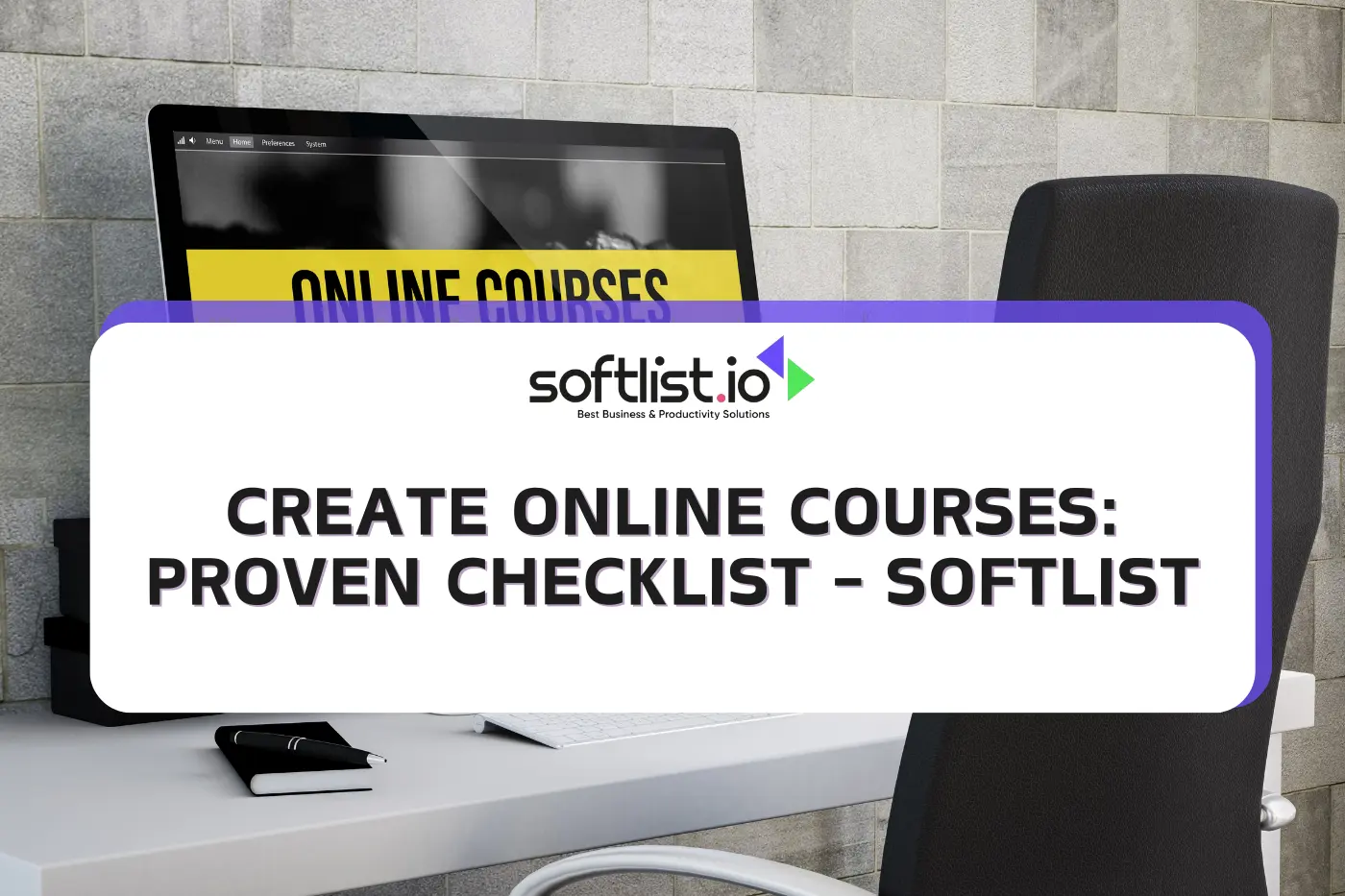Creating online courses has become a game-changer for learners and educators alike, offering unparalleled flexibility and access to knowledge. I’ll never forget the achievement I felt when launching my first online course.
It was a blend of excitement and nervousness, knowing I could reach students across the globe. This experience taught me the importance of a well-thought-out course design and the right tools to bring it to life.
In this guide, we’ll walk you through the definitive checklist for creating online courses, ensuring you’re equipped to share your knowledge effectively.
Here is what to expect:
- Choosing the Right Platform: Insights on selecting platforms that enhance user experience and offer great value.
- Designing Your Course Content: Tips for crafting content that engages and educates, from structuring your modules to keeping your audience captivated.
- Tools for Course Creation: An overview of the essential software and tools that simplify the course creation process.
- Monetizing Your Course: Strategies to turn your course into a revenue stream.
- Marketing and Launching Your Course: Key steps to promote your course and attract learners.
Starting the process of making online courses is an exciting adventure. This checklist is meant to help you succeed and ensure that your courses reach your target audience and connect with them.
Essential Checklist for Creating Online Courses
To make a successful digital learning experience, you must plan and carry it out carefully. This Essential Checklist to make an online course is your complete guide, showing you how to do important things like choosing the right platform, designing strategic content, making money, and marketing to the right people.
Whether you’re an educator looking to expand your reach or a professional aiming to share your expertise, this checklist is your key to turning knowledge into a compelling online course.
- Platform Selection:
- Evaluate and choose the right online learning platform based on your target audience and course requirements.
- Consider user-friendly interfaces, technical support, and scalability for future growth so that the course is accessible anytime the user needs it.
- Explore features such as video hosting, interactive online quizzes, engaging online discussion forums, and ensure the course analytics.
- Strategic Content Design:
- A strategic content design needs a course structure and course outline to guide your students through a logical learning path.
- To enhance engagement, utilize multimedia elements, such as videos, slides, and interactive quizzes.
- Make your online course to be inclusive. Implement a variety of learning activities to cater to different learning styles.
- Monetization Strategies:
- Determine your pricing model (one-time purchase, subscription, or tiered pricing) based on your goals and target audience.
- Explore options like offering free trials, bundling courses, or creating membership programs.
- Consider promotional strategies to market your online course and build a sustainable revenue stream.
- Targeted Marketing Approaches:
- Develop a marketing course plan that includes social media, email campaigns, and partnerships to reach your target audience.
- Leverage search engine optimization (SEO) techniques to enhance the discoverability of your courses.
- Utilize analytics to track marketing performance and adjust strategies accordingly.
- Transforming Knowledge into a Compelling Digital Learning Experience:
- Focus on creating engaging and interactive content that promotes active learning.
- Implement feedback loops through quizzes, surveys, and discussion forums to understand and address student needs.
- Stay updated on industry trends and continuously refine your courses to provide relevant and valuable content.
This checklist is a roadmap for educators and professionals, guiding you through the intricacies of online course creation. As you navigate through these essential elements, you’ll share your expertise and create a dynamic and enriching digital learning experience for your audience.
Choosing the Right Platform

Picking the right platform is important for anyone or any business aiming to have an online presence. With so many choices, it can be tough to figure out which one will work best for your goals, audience, and tech needs.
In this section, we’ll go over what you should think about when choosing a platform, and your different options and give you some handy tips to help you make a decision that fits your unique needs.
Udemy
Udemy is one of the most popular online course platforms. It offers a vast selection of courses across different subjects. The user experience is good, with easy navigation and search functionality. Courses are priced individually, and instructors have control over pricing. Udemy also frequently offers discounts. Its features include lifetime access to course materials, downloadable resources, and a community forum for discussions.
Coursera
Coursera primarily collaborates with universities and offers courses created by professors. It has a clean user interface and offers both free and paid courses. Coursera implements a subscription-based model, where users pay a monthly fee to access most of the courses. It provides a comprehensive learning experience with assignments, quizzes, and discussion forums. Additionally, Coursera offers specialization programs comprising multiple courses.
Khan Academy
Khan Academy is an entirely free online learning platform. It covers a wide range of subjects, especially focusing on academic topics. Its user experience is intuitive, making navigating various topics and lessons easy.
LinkedIn Learning
Formerly known as Lynda.com, LinkedIn Learning offers many courses industry professionals teach. This platform offers a user-friendly experience, allowing easy progress tracking and bookmarking of courses. Pricing is subscription-based, granting access to the entire course library.
Teachable
Teachable is a popular platform known for its user-friendly interface and ease of use for both course creators and students. It offers customization options to create branded course websites. Teachable operates on a monthly subscription model, with additional fees for payment processing. Features include integrated email marketing, student analytics, and creating membership sites.
Skillshare
Skillshare is a platform where instructors can offer courses on creative skills, such as design, photography, and writing. Users pay a subscription fee to access all courses. Skillshare fosters a strong community experience with opportunities for students to interact and collaborate.
Designing Your Course Content

Crafting compelling course content is the key to effectively building your course online. The structure of your modules plays a crucial role in capturing your learners’ attention and delivering valuable knowledge.
Here are some essential tips to help you structure your modules for maximum engagement and effectiveness:
- Set clear learning objectives: Before diving into the content, clearly define the learning objectives for each module. Choose the perfect course topic suitable for the community around your course. This will help you maintain focus and ensure your content is relevant and meaningful to your learners throughout the course.
- Start with an introduction: Begin each module with an introduction that outlines what learners can expect to gain from the module. This will generate curiosity and set the foundation for their learning journey.
- Break content into digestible chunks: Avoid overwhelming your learners with large blocks of text or lengthy videos in building your course. Break down your content into smaller, easier-to-digest sections. Use headings, subheadings, bullet points, and visuals to enhance readability and comprehension.
- Use a variety of media formats: Different people have different learning preferences, so make sure to incorporate a variety of media formats to cater to different learning styles. Make your course as interactive as possible. Use text, images, videos, quizzes, and interactive elements to engage your learners.
- Incorporate real-life examples and case studies: Relate your content to real-life examples and case studies to make it more relatable and practical. This course idea helps learners understand how their learning concepts can be applied in real-world situations.
- Implement active learning techniques: Engage learners in active learning by including activities, discussions, and assignments within each module. It should also be in line with the course curriculum. This encourages them to actively participate and apply their knowledge, which leads to better retention and understanding.
- Provide opportunities for self-assessment: Online education doesn’t mean learning passively. It also includes quizzes, assessments, or interactive exercises throughout each module to help learners gauge their understanding and progress. This also allows them to identify areas needing further clarification or practice.
- Provide clear summaries and recaps: At the end of each module, provide a summary or recap of the key points covered. This reinforces the learning and helps learners review and retain the information more effectively.
- Include opportunities for feedback and discussion: Encourage learner interaction by providing opportunities for feedback and discussion. This can be through discussion forums, Q&A sessions, or feedback surveys. Not only does this enhance the learning experience, but it also fosters a sense of community and engagement.
- Continuously update and improve your content: Create profitable content. Regularly review and update your course content to remain relevant and up-to-date. Seek feedback from learners and make necessary improvements based on their suggestions.
Structuring Your Modules
When creating your online course, define what you want your students to learn. Break these goals down into smaller, bite-sized lessons. Add videos, quizzes, and chat forums to make the course more engaging.
Arrange your lessons logically, with each concept building on the previous one. Use clear headings and bullet points to make your content easy to read and follow. Keep a consistent look and feel throughout your course regarding layout and design. And remember, always be open to feedback and ready to tweak your course to improve it.
Engaging Your Audience
Use interactive elements such as videos, quizzes, and discussion forums to create engaging content. Break up the content into smaller sections and use visuals and storytelling techniques to captivate your audience. Encourage active participation, provide real-world examples, and tailor the content to be relevant and meaningful to the learners.
Tools for Course Creation
When it comes to creating digital courses, having the right software and tools can greatly enhance the learning experience for your students. Here are some best platforms for creating your course, including online course creation tools and digital course creation software:
- Learning Management Systems (LMS): LMS platforms are the central hub for creating, managing, and delivering online courses. They typically provide features like content creation, assessment tools, and student management. Popular LMS options include Moodle, Canvas, and Blackboard. Many courses for free are offered.
- Content Creation Tools: To engage learners effectively, you need tools for creating interactive and multimedia-rich content. Tools like Articulate Storyline, Adobe Captivate, and Camtasia enable you to create interactive videos, presentations, quizzes, and assessments.
- Video Editing Software: Video content plays a crucial role in online courses. Video editing software such as Adobe Premiere Pro, iMovie, or Sony Vegas allows you to create your content by editing and enhancing your recorded lectures, adding captions, annotations, and transitions for a professional look.
- Screen Recording Tools: Screen recording tools are very important when teaching online. When demonstrating software or presenting slides, screen recording tools like Screencast-O-Matic, OBS Studio, or Camtasia can capture your screen activities, enabling you to create tutorials or walkthroughs.
- Multimedia Creation Tools: To add visual appeal and engage your learners, graphic design tools like Canva, Adobe Spark, or Piktochart help create stunning infographics, presentations, or images to enhance your course materials.
- Virtual Classroom Software: Online course creation tools often include virtual classroom features where you can conduct live sessions, interact with learners, and share resources. Popular options include Zoom, Adobe Connect, or BigBlueButton.
- Learning Content Management Systems (LCMS): LCMS platforms like Elucidat, Evolve, and EasyGenerator streamline the course creation with content authoring and management features. They offer templates, collaborative editing, and version control for efficient content development.
- Assessment and Quiz Tools: Assessing student progress is essential, and tools like Google Forms, Quizlet, or ProProfs enable you to create quizzes, surveys, and assessments to evaluate the learning outcomes effectively.
Monetizing Your Course
Monetizing your course is essential in turning your knowledge and expertise into a profitable venture. By implementing effective strategies, you can create a profitable course and enhance your course’s value and reach.
- You need to create premium content and offer it that you can price your course, such as exclusive advanced courses or specialized training programs, to attract and engage a niche audience.
- Implementing a subscription-based model, where learners pay a recurring fee to access a library of courses or receive ongoing updates and support.
- Partner with other organizations or influencers to host joint webinars or market your course in an online course marketplace to expand the reach and generate additional revenue through affiliate marketing.
Marketing and Launching Your Course
Launching and marketing your course is a must if you want it to be successful and reach a lot of people. It means coming up with smart ways to market your course, focusing on the right people, and making interesting content showing your offering is valuable. Using these methods, you can make your course more visible and attract potential students.
- Create compelling course content: Create a profitable online course with high-quality course materials that offer valuable knowledge and solutions to a target audience’s pain points. When you create great courses then the users will walk the talk.
- Build a professional online course platform: Choose a reliable e-learning platform and customize it to match your brand, ensuring a user-friendly interface and seamless navigation.
- Implement effective marketing strategies: Utilize various digital marketing techniques such as social media campaigns, email marketing, and search engine optimization to raise awareness and attract potential students.
- Leverage partnerships and collaborations: Collaborate with influencers, industry experts, and affiliates to extend your reach and tap into their existing audiences.
- Monitor and optimize your course: Analyze student feedback, engagement metrics, and sales data to improve your course content, platform usability, and marketing strategies for better results. You can market your course easily when you have good feedback from your students.
Key Takeaway
Consider our checklist your trusty sidekick in creating a top-notch online course. From planning to interacting with your students, we’ve covered all the steps to help you make your course a hit.
Let’s talk about marketing and launching your course – it’s a biggie! You’ve got to know who you’re talking to, make your course content irresistible, have a killer marketing game plan, and use the right platforms to get the word out.
Do it right, and you’ll get your course in front of the right people, make a real impact, and maybe even make a pretty penny while you’re at it!
FAQs – Create Online Courses
What are the best practices for pricing online courses?
The best practices for pricing online courses can include conducting market research, offering different pricing options, and regularly reviewing and adjusting the prices based on feedback and demand.
How can I protect my online course content from piracy?
To protect online course content from piracy, use technology such as watermarking, encryption, and platforms with strong security features, implement strict copyright policies, and monitor for potential infringements.
What is the average completion rate for online courses, and how can I improve it?
The average completion rate for online courses varies. Still, it is generally lower than in-person courses, and to improve it, course creators can focus on clear and engaging instructional design, setting realistic expectations, providing ongoing support, and incorporating interactive elements.
How do I choose the right course topic that guarantees engagement?
Choosing the right course topic that guarantees engagement involves considering market demand and trends, identifying learners’ pain points and interests, conducting research and surveys, and strategically positioning the course to target a specific niche audience.
What are the legal considerations when creating online courses?
When creating online courses, legal considerations include copyright compliance, using legally obtained materials, obtaining necessary licenses or permissions, adhering to privacy and data protection laws, disclosing any disclaimers or warranties, and ensuring compliance with international laws if offering courses globally.
Empower Your Online Teaching Journey with Softlist.io!
Take your online teaching to the next level with Softlist! Our platform offers many tools and features to enhance your teaching experience. Sign up now and empower your students with interactive lessons, real-time feedback, and seamless collaboration.
Join Softlist today to change how you teach online courses and don’t miss out on this chance!






